Fitting a new boiler can indeed be messy, as pipe disconnections may lead to leaks and debris can accumulate during removal. However, skilled professionals typically manage cleanup effectively, minimizing disruption. Proper preparation—like clearing the installation area and using protective coverings—can further reduce mess. Communication with your installer also helps address concerns. If you'd like to discover more about managing the installation process and ensuring a smoother experience, there's plenty more to explore.
Key insights
- Fitting a new boiler can create mess from dust, dirt, and debris in the installation area.
- Old unit removal generates waste and packaging materials that contribute to the mess.
- Professional installers typically manage cleanup effectively, minimizing the mess left behind.
- DIY installations may result in an underestimated mess, complicating the cleanup process.
- Proper preparation and communication with installers can help reduce mess during the installation.
Understanding the Boiler Replacement Process
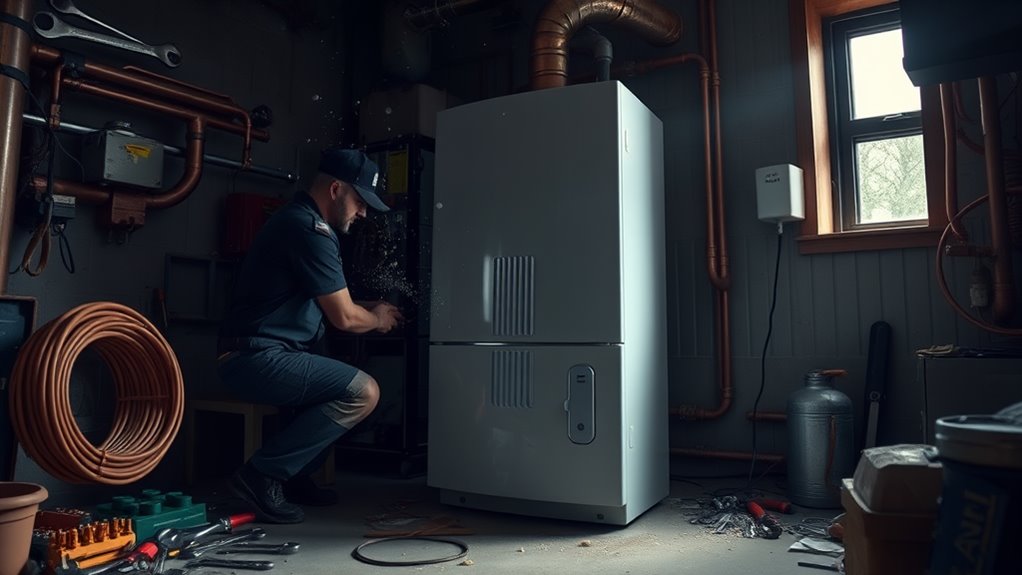
When you decide to replace your boiler, understanding the replacement process can help alleviate concerns about potential mess. First, familiarize yourself with the different boiler types, such as combi, system, and conventional boilers. Each type has unique installation requirements that can affect the overall process. Next, take note of the installation timeline, which typically ranges from a few hours to a full day, depending on the complexity of the job and the type of boiler. During installation, professionals usually take measures to minimize disruption, like using protective coverings. Communicating with your installer about your concerns can guarantee they address specific issues, making the entire procedure smoother and cleaner. Additionally, hiring qualified installers ensures that the installation adheres to safety regulations and minimizes any potential mess. Being informed can greatly reduce your anxiety regarding the boiler replacement.
Preparing Your Home for Installation
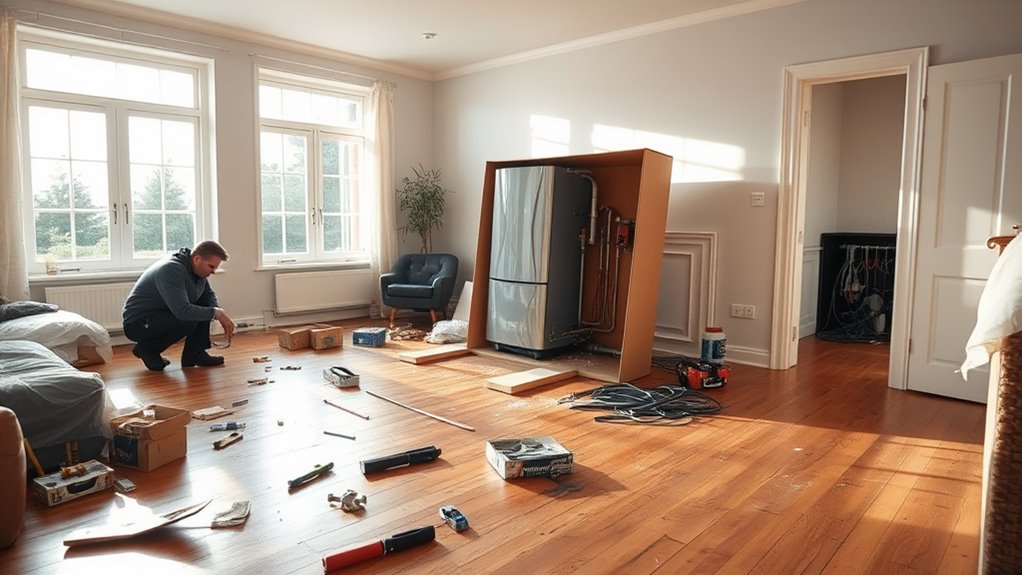
Before the installation crew arrives, you can take several steps to prepare your home and minimize any potential disruption. Effective home organization and space clearance are essential for a smooth installation process. Here are three key actions you can take:
- Clear the Installation Area: Remove furniture, decorations, and obstacles around the boiler location to guarantee easy access for the crew.
- Designate a Work Zone: Create a specific area for tools and materials, keeping them out of high-traffic spaces to enhance safety.
- Protect Your Flooring: Lay down protective coverings where the crew will work to prevent damage to your floors. Additionally, ensuring regular servicing of your boiler can help identify potential issues before installation, making the process more efficient.
The Installation Day: What to Expect
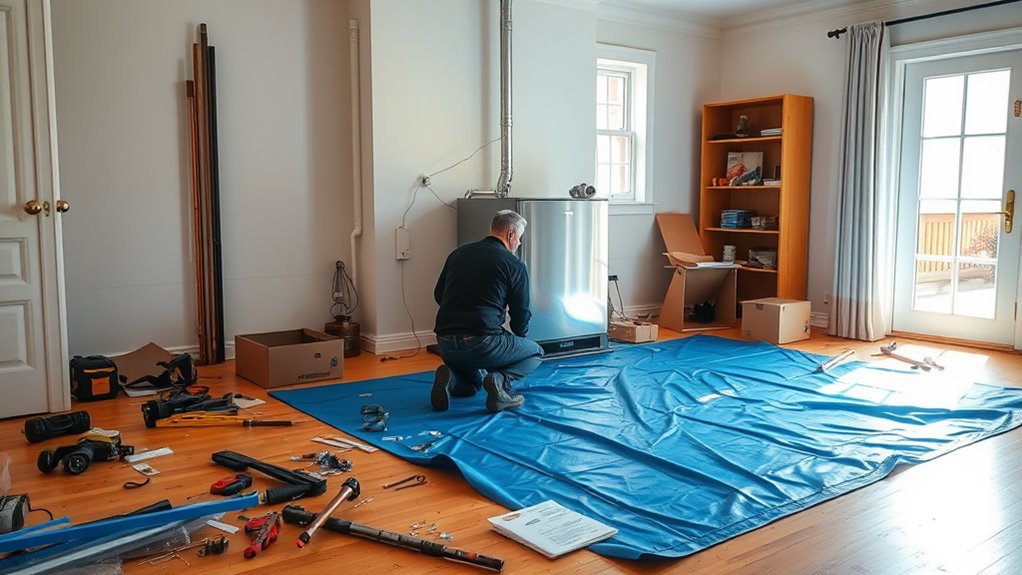
As the installation day arrives, you can expect the crew to work efficiently and systematically to replace your old boiler. The installation timeline typically spans several hours, depending on the complexity of the job. Your installers will arrive punctually, equipped with all necessary tools and materials. They'll begin by removing the old unit, ensuring safety protocols are followed. Throughout the process, clear installer communication is essential; you should feel free to ask questions or request updates on the progress. Expect them to test the new boiler thoroughly once installed, ensuring everything functions correctly. Additionally, proper preventative maintenance after installation will help ensure the new system operates efficiently and lasts longer. By the end of the day, your home will be ready to enjoy the benefits of a new heating system without unnecessary disruption.
Common Sources of Mess During Installation
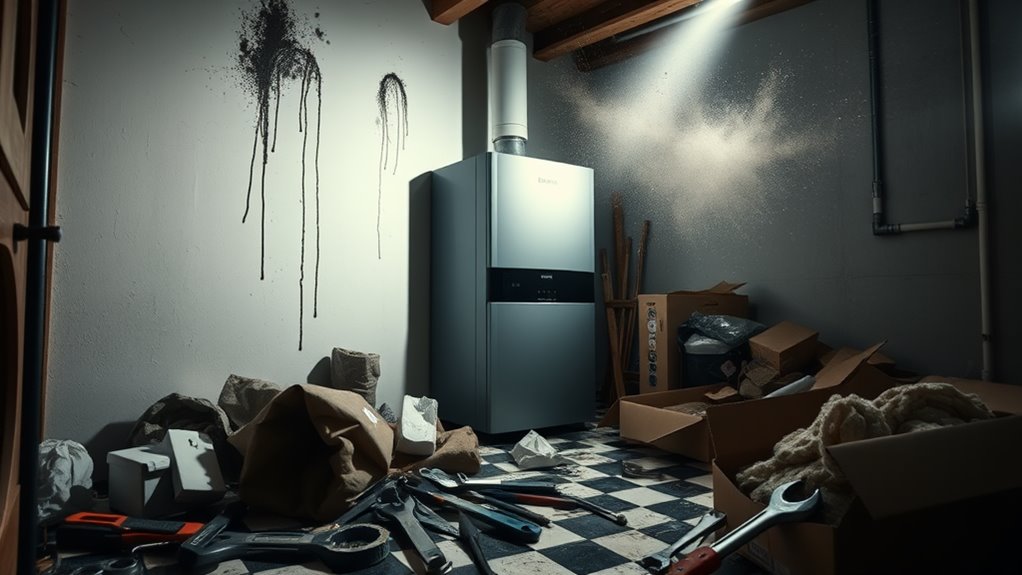
Certainly! Here's the revised content with the new sentence added:
Although the installation of a new boiler is designed to be efficient, several common sources of mess can arise during the process. Understanding these sources can help you prepare for cleanup.
- Pipe disconnections: Removing old pipes can lead to leaks and spills, creating a mess that needs immediate attention.
- Debris management: Dust, dirt, and other debris often accumulate in the installation area, requiring thorough cleaning afterward.
- Old boiler removal: The removal of the old unit can generate additional waste, including broken components and packaging materials. Additionally, proper maintenance practices can help minimize the mess created during installation.
Professional vs. DIY Installation Cleanup
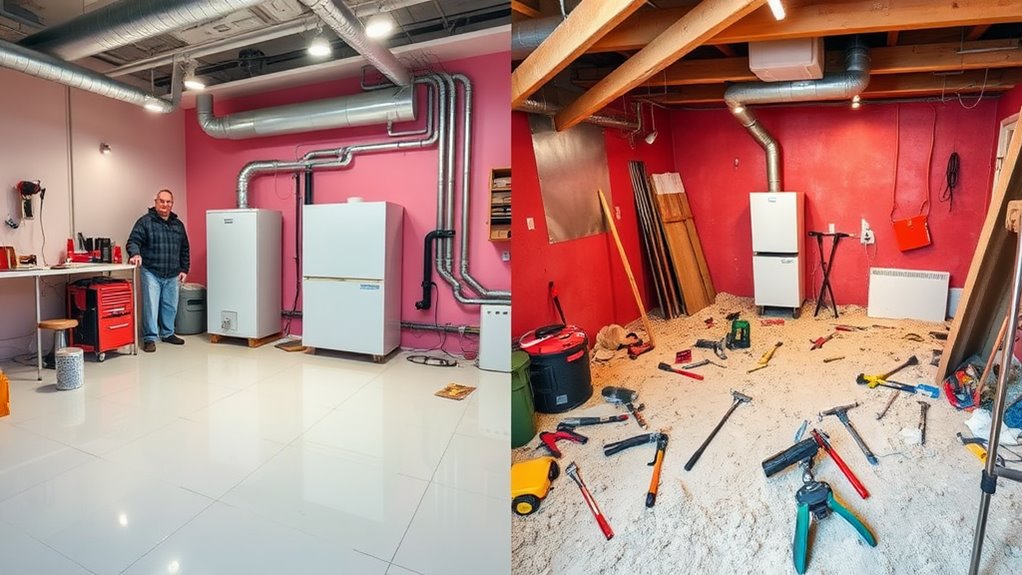
Cleaning up after a boiler installation can vary considerably between professional and DIY approaches. In professional installations, experienced technicians typically take care of the cleanup process, ensuring minimal mess is left behind. They use specialized tools and techniques to manage debris, dust, and any leftover materials effectively. This often results in a cleaner environment post-installation.
On the other hand, if you opt for a DIY installation, you may face various challenges. Without experience, you might underestimate the mess generated. Improper handling of tools can lead to spills or scattered debris, making cleanup more complicated. Ultimately, if you value a tidy space, professional installations might be the better choice for hassle-free cleanup. Additionally, engaging a Gas Safe registered engineer ensures that the installation meets safety standards, further minimizing the risk of future issues.
Minimizing Disruption During the Process
To minimize disruption during your boiler installation, thorough preparation and planning are essential. You should guarantee that the work area is clear and accessible before the technicians arrive. Implementing effective clean-up procedures afterward will further reduce any mess and restore your space quickly. Additionally, considering a professional power flush before installation can optimize your heating system's efficiency and help prevent future issues.
Preparation and Planning
When you're preparing for a new boiler installation, careful planning can greatly minimize disruption in your home. To guarantee a smooth process, consider these key factors:
- Budget considerations: Assess your financial limits and choose a boiler that fits within your range while factoring in installation costs.
- Timeline management: Set a clear schedule for the installation, coordinating with your contractor to guarantee they're available when you need them.
- Space preparation: Clear the installation area of any furniture or obstacles to allow easy access for technicians. Additionally, consider consulting with experienced commercial heat pump specialists to explore energy-efficient options that may suit your needs.
Clean-Up Procedures
After preparing your space and setting a timeline, addressing clean-up procedures can markedly reduce the mess typically associated with boiler installations. Start by implementing effective cleaning techniques, such as using drop cloths and plastic sheeting to protect floors and furniture. This minimizes the risk of debris scattering during the installation process.
During the installation, maintain a systematic approach to debris management. Have designated containers for waste and old materials to guarantee easy disposal. Regularly check the work area to remove any leftover debris, which keeps the space organized and safe.
After the installation, conduct a thorough final clean-up, vacuuming any residual dust and guaranteeing that all surfaces are left pristine. This attention to detail makes a significant difference in your overall experience. Additionally, ensuring that the system pressure is optimal post-installation can help prevent future boiler errors.
Post-Installation Cleaning and Maintenance
Once your new boiler is installed, it's crucial to prioritize post-installation cleaning and maintenance to guarantee peak performance. Neglecting this step could lead to inefficiencies and potential issues down the line. Here are some effective cleaning tips:
- Inspect for debris: Regularly check for dust and debris around the boiler to prevent blockages.
- Check connections: Verify all pipes and fittings are secure to avoid leaks and improve efficiency.
- Schedule professional maintenance: Consider annual servicing by a qualified technician to spot issues early. Additionally, regular inspections can help identify common error codes that may arise, ensuring timely action is taken to maintain your boiler's functionality.
Implementing these post-installation maintenance practices will help maintain your boiler's efficiency and longevity. Don't overlook these steps; staying proactive will save you time and money in the long run.
Tips for Choosing a Reliable Installer
Selecting a reliable installer is key to ensuring your new boiler operates efficiently and safely. Start by checking the installer qualifications; they should be Gas Safe registered and have relevant certifications. This guarantees they're trained to handle boiler installations per safety standards. Next, explore customer reviews. Look for feedback on their work quality, punctuality, and professionalism. Websites like Trustpilot or local directories can provide insights into previous clients' experiences. Don't hesitate to ask for references from the installer, as this can further validate their reliability. Finally, obtain multiple quotes to compare services and prices, ensuring you get a fair deal without compromising quality. Making an informed choice now can save you time and money in the long run. Regular maintenance can also help prevent error codes that may arise from installation issues.
Frequently Asked Questions
How Long Does the Boiler Installation Process Typically Take?
The boiler installation process typically takes between 4 to 8 hours, depending on your home's layout and the complexity of the system. Factors like removing the old boiler, making necessary adjustments, and ensuring proper ventilation can affect the boiler installation timeline. A skilled technician can streamline the installation process duration, ensuring everything's up to code and functioning efficiently. Expect a thorough check once it's done to guarantee peak performance.
Will My Heating System Need Adjustments After the New Boiler Is Installed?
After installing your new boiler, you'll likely need to make adjustments to your heating system. These changes enhance system efficiency and optimize heating performance. You might need to balance radiators, check pressure levels, or recalibrate controls to guarantee everything works harmoniously. It's essential to have a professional evaluate these aspects post-installation, confirming your new boiler operates at its best and meets your home's heating demands effectively.
Can I Stay in My Home During the Boiler Installation?
Yes, you can stay in your home during the boiler installation, but it may affect your comfort temporarily. The installation process typically involves some noise and disruption, especially if you have to move furniture or access certain areas. However, most professionals work efficiently to minimize the impact on your daily routine. Make sure you discuss any specific concerns with your installer to maintain your home comfort throughout the process.
What Types of Boilers Are Easiest to Install?
When considering boiler installation, combi boilers and system boilers are often the easiest to install. Combi boilers are compact and combine heating and hot water in one unit, requiring minimal pipework. System boilers, while slightly larger, come with built-in components that simplify installation. Both options typically need less space and fewer modifications to your existing system, making them convenient choices for quicker installations, ensuring you stay comfortable in your home with minimal disruption.
How Often Should I Replace My Boiler?
You should consider replacing your boiler every 10 to 15 years, depending on its lifespan and performance. Keep an eye out for replacement signs like unusual noises, increased energy bills, or inconsistent heating. If your boiler shows these symptoms, it may be time to upgrade. Regular maintenance can also help extend its life, but when it starts breaking down frequently, replacing it is often the most cost-effective solution.
Summary
To sum up, fitting a new boiler can involve some mess, but with proper preparation and a professional installer, you can minimize disruption. Clear the installation area and communicate your concerns to guarantee a smoother process. While DIY options may save costs, they often lead to more mess and complications. Post-installation, prioritize cleaning and maintenance to keep your system running efficiently. By choosing a reliable installer, you can achieve a less chaotic experience during your boiler replacement.

